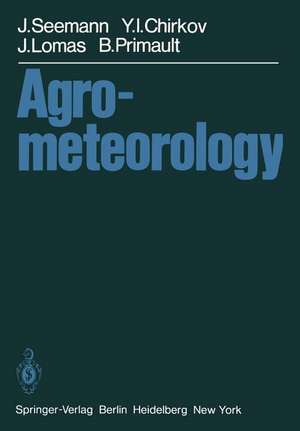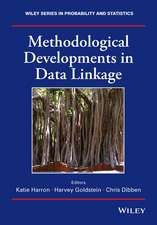Agrometeorology
Autor J. Seemann, Y. I. Chirkov, J. Lomas, B. Primaulten Limba Engleză Paperback – 27 feb 2012
Preț: 644.82 lei
Preț vechi: 758.60 lei
-15% Nou
Puncte Express: 967
Preț estimativ în valută:
123.40€ • 128.36$ • 101.88£
123.40€ • 128.36$ • 101.88£
Carte tipărită la comandă
Livrare economică 14-28 aprilie
Preluare comenzi: 021 569.72.76
Specificații
ISBN-13: 9783642672903
ISBN-10: 3642672906
Pagini: 340
Ilustrații: VIII, 326 p.
Dimensiuni: 170 x 244 x 18 mm
Greutate: 0.54 kg
Ediția:Softcover reprint of the original 1st ed. 1979
Editura: Springer Berlin, Heidelberg
Colecția Springer
Locul publicării:Berlin, Heidelberg, Germany
ISBN-10: 3642672906
Pagini: 340
Ilustrații: VIII, 326 p.
Dimensiuni: 170 x 244 x 18 mm
Greutate: 0.54 kg
Ediția:Softcover reprint of the original 1st ed. 1979
Editura: Springer Berlin, Heidelberg
Colecția Springer
Locul publicării:Berlin, Heidelberg, Germany
Public țintă
ResearchDescriere
Agrometeorology is a comparatively young science. The beginnings of agrometeorological work came in the 20's of this century, when agrometeorology was a working branch of climatology. In the years following 1950 it then developed widely to an independent science. In this process, agrome teorology has not only gained a vast knowledge of the influence of meteorological conditions on plants and livestock in agriculture and damage prevention, but additionally evolved new advisory methods which are of great practical use in agriculture. Up to the present time there has been practically no specific training for an agrometeorologist. Agrometeoro logists are drawn, according to their training, from the ranks of general meteorology or from agriculture and its related biological disciplines. They must, therefore, them selves gather the knowledge for their agrometeorological work and combine for themselves the complex of agrome teorology from biological and meteorological information. This is usuaIIy far from easy, as the relevant literature is scattered among the most widely differing journals, partly in little-known foreign languages, and is thus very difficult of access. Comprehensive writings are to be found only in very few partial fields of agrometeorology. The subject of training problems has thus been treated as of utmost importance at the meetings ofthe Commission for Agrometeorology (CAgM) of the World Meteorological Organization (WMO), especially as agrometeorology has won such great significance and useful ness not only in the so-called underdeveloped countries in advancing a more productive agriculture, but also in coun tries whose agricultural standard is already high.
Cuprins
I Introduction.- The Atmosphere from an Ecological Viewpoint..- II Physical and Meteorological Principles of Agrometeorology.- 1 Solar Radiation..- 2 The Biological Effects of Light..- 3 Net Radiation..- 4 Radiation Measurement Technology..- 5 Heat Balance..- 6 Heat Flux in the Soil..- 7 Heat Transport in the Air..- 8 Measuring Technology..- 9 Transfer of Quantities of Air Masses..- 10 The Wind..- 11 Transportation of Particles by Air Masses.- 12 Wind Measurement..- 13 Future Development of Measuring Techniques and Research in Agrometeorology..- III Applied Agrometeorology.- 1 Agricultural Climatology..- 2 Agrometeorological Statistics and Models..- 3 Agrotopoclimatology..- 4 Soil Climate..- 5 Microclimate and Phytoclimate..- 6 The Climate of Meadows and Pastures..- 7 The Climate of Grain Crops..- 8 The Climate of Trees, Orchards, and Forests..- 9 Improving a Climate for Agricultural Purposes..- 10 Greenhouse Climate..- 11 Open Fields and Shade..- 12 Optimum Climate for Animals..- 13 The Climate Inside Animal Shelters..- 14 Plant Climate (Heating and Cooling)..- 15 Droughts, Dry Winds, Dust Storms, and Hail..- 16 Irrigation..- 17 Special Forecasts..- 18 Agrometeorological Forecast Systems..- 19 Forecasting the Minimum Temperature..- 20 Epidemiology of Insects and Other Diseases..- 21 Water Requirements of Plants..- 22 The Climate of Agricultural Produce in Transport and Storage..- 23 Usefulness of Agroclimatology in Planning..- 24 Use of Agroclimatology in Crop Distribution..















